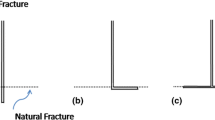Abstract
The cross extension of hydraulic fracture and natural fracture is the key to realize the volume fracture in unconventional reservoir. Based on the non-continuum theory, with the help of numerical simulation algorithm, a mathematical model for in-situ stress about fracturing expansion when the hydraulic fracture intersects with a natural fracture is presented. Then, using two-dimensional linear elastic theory verify the validity of degenerate in-situ stress mode. So it makes the natural fissure error about natural fracture surface pressure less than 1%. As a result, the accuracy of the model was proved. On the basis of the above, considering fluid-structure coupling effect, the stress change rules on natural fracture surface are obtained during hydraulic fracture extension process. The calculation results are as follows: In the process of hydraulic fracture approaching natural fracture, the surface of natural fracture occurs shear deformation first, and then turns into open deformation. Under the influence of shear deformation, the direction of the maximum principal stress on natural fracture surface is the same as initial horizontal maximum principal geostress. Due to the expansion of hydraulic fracture and fracture tip concentration effect, the maximum principal stress appears in the hydraulic fracture tip, this two points may induce the natural fracture begin to extend. And for initial ground stress in a stratum, the smaller the difference, the greater the pressure required to open the natural fracture. At this time, the maximum principal stress on the surface of the natural fracture is less concentrated; multiple fracture initiations are easily formed. Under high pressure, when the approaching angle between natural fracture and hydraulic fracture closes to 45° hydraulic fracture is easier to activate natural fracture, the formed hydraulic fracture shape is more complicated.











Similar content being viewed by others
References
Zuo, C., Chengjin, X., Tingxue, J., et al. (2010). Proposals for application of fracturing by stimulated reservoir volume (SRV) in shale gas wells in China. Natural Gas Industry, 30(10), 30–32.
Mahrer, K. D. (1999). A review and perspective on far-field hydraulic fracture geometry studies. Journal of Petroleum Science and Engineering, 24(1), 13–28.
Kresse, O., Weng, X. W., Gu, H. R., et al. (2013). Numerical modeling of hydraulic fractures interaction in complex naturally fracture formations. Rock Mechanics Rock Engineering., 46, 555–568.
Rahman, M. M., & Rahman, S. S. (2013). Studies of hydraulic fracture-propagation behavior in presence of natural fractures: fully coupled fractured-reservoir modeling in poroelastic environments. International Journal of Geomechanics, 13, 809–826.
Michael, P., & Raghavan, R. (2013). The effect of skins at a natural fracture crossed normally by a finite horizontal well. SPE Journal, 4, 233–242.
Lamont, N., & Jessen, F. (1963). The effects of existing fractures in rocks on the extension of hydraulic fractures. Journal of Petroleum Technology, 15(2), 203–209.
Blanton, T. L. (1986). Propagation of hydraulically and dynamically induced fractures in naturally fractured reservoirs. SPE 15261.
Chitrala, Y., Moreno, C., Sondergeld, C., et al. (2013). An experimental investigation into hydraulic fracture propagation under different applied stresses in tight sands using acoustic emissions. Journal of Petroleum Science and Engineering, 108, 151–161.
Mian, C., Fei, P., & Yan, J. (2000). Experiment and analysis on hydraulic fracture by a large size triaxial simulator. Chinese Journal of Rock Mechanics and Engineering, 19(6), 868–872.
Warpinski, N. R., & Teufel, L. W. (1987). Influence of geologic discontinuities on hydraulic fracture propagation. Journal of Petroleum Technology, 39(2), 209–220.
Zhao, J., Ren, L., & Hu, Y. (2013). Controlling factors of hydraulic fractures extending into network in shale formations. Journal of Southwest Petroleum University, 35(1), 1–9.
Funding
The authors are grateful for the support of the National Basic Research Program of China (973 Program) (2015CB250900) and Natural Science Foundation of China (51374074).
Author information
Authors and Affiliations
Corresponding author
Rights and permissions
About this article
Cite this article
Wang, S., Jiang, M., Dong, K. et al. Fracture Cross Extension Arithmetic Research Based on Non-continuum Theory. Wireless Pers Commun 103, 41–53 (2018). https://doi.org/10.1007/s11277-018-5424-z
Published:
Issue Date:
DOI: https://doi.org/10.1007/s11277-018-5424-z




